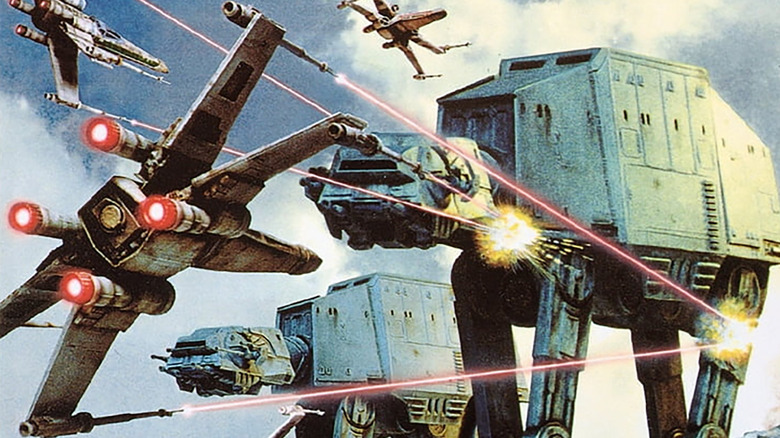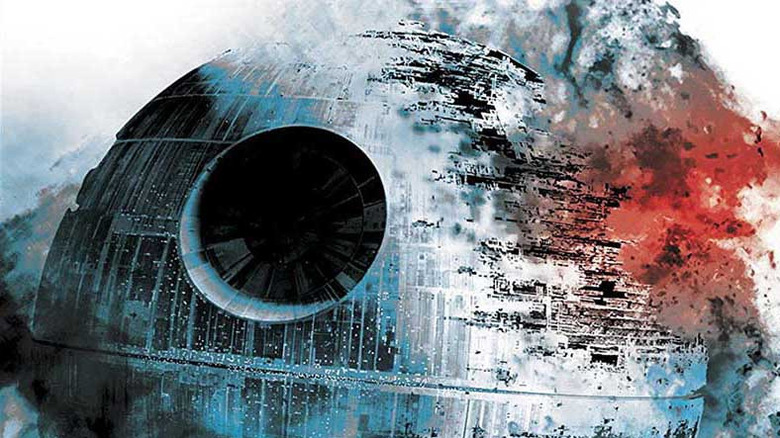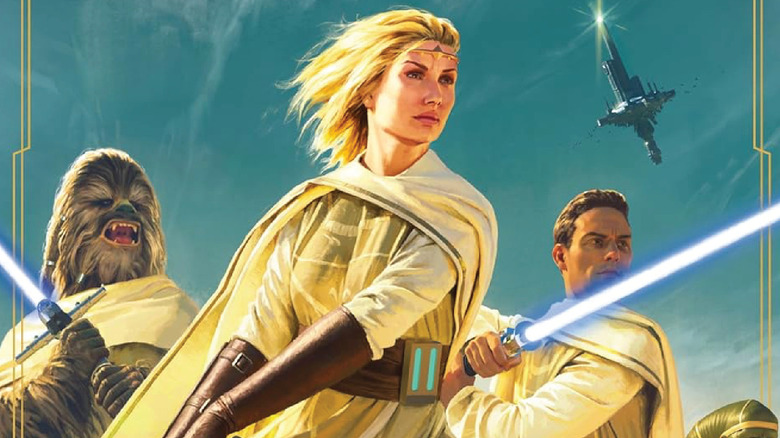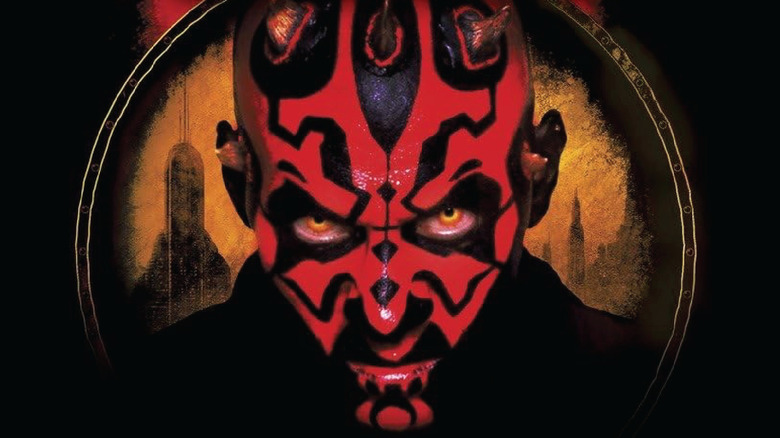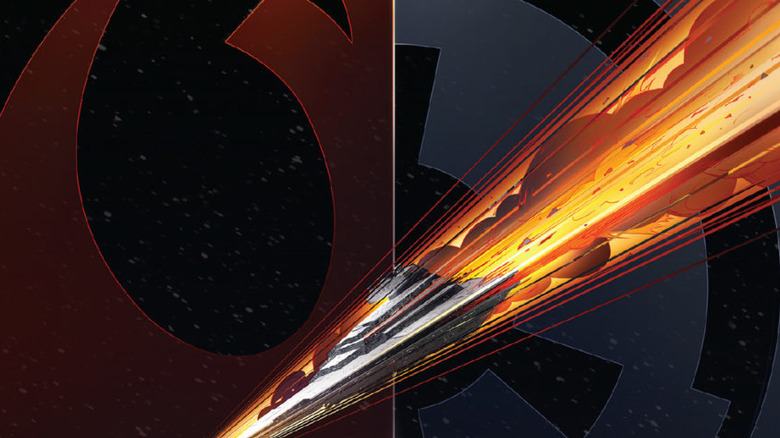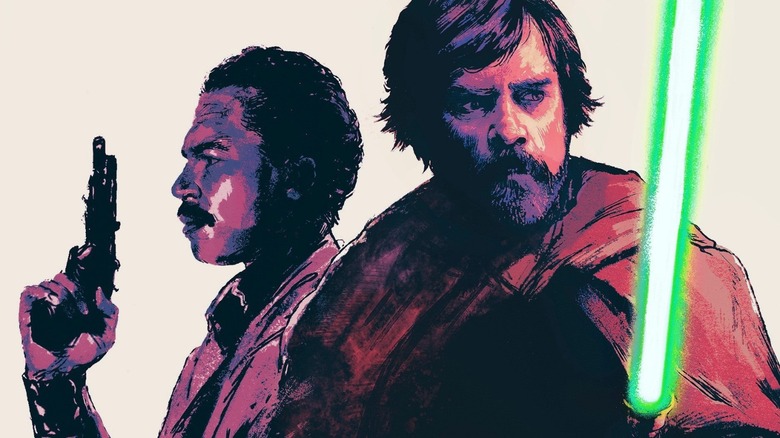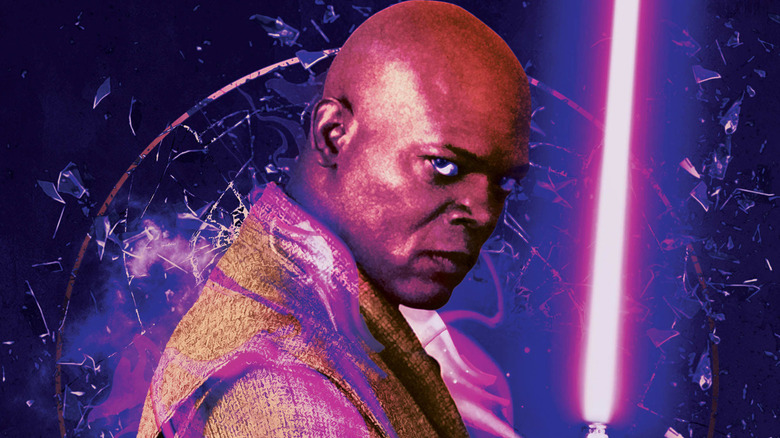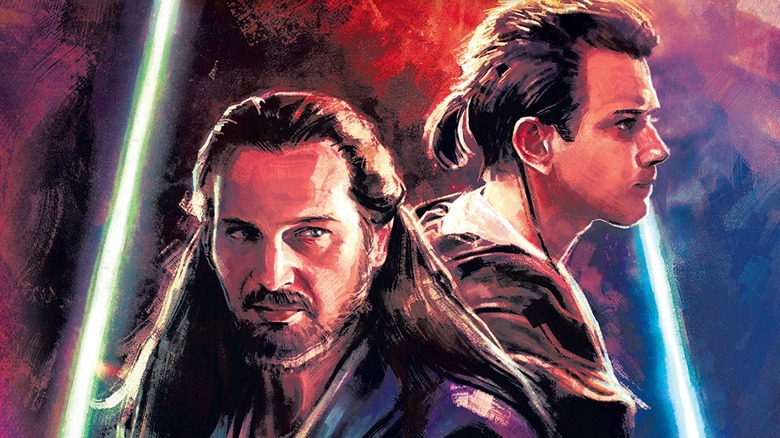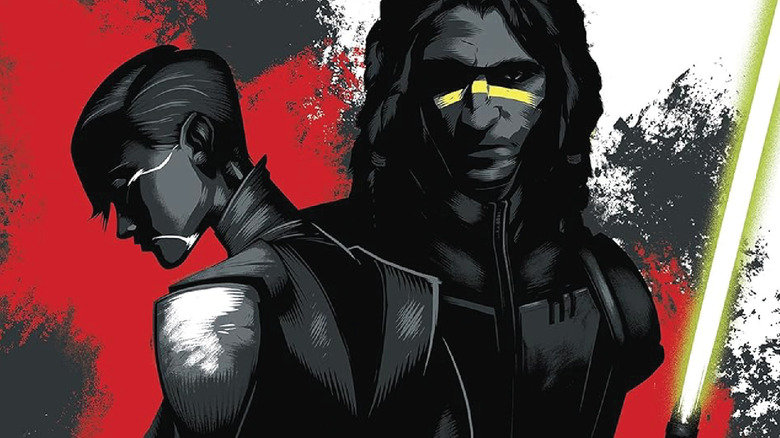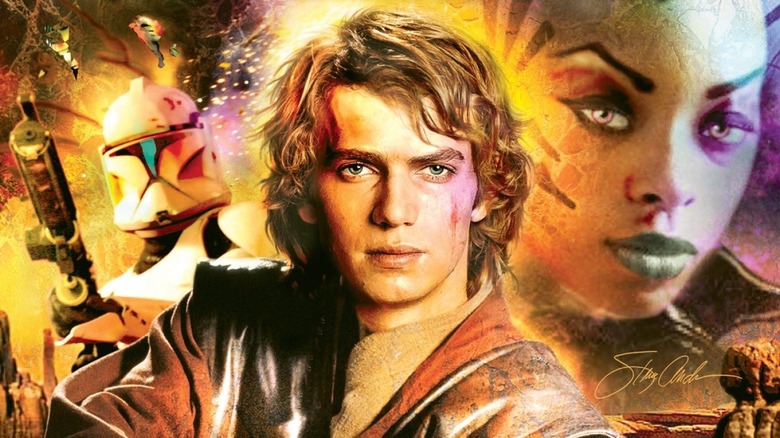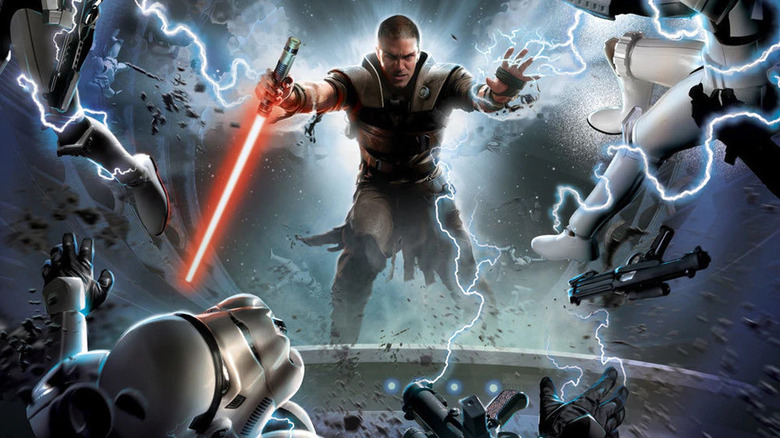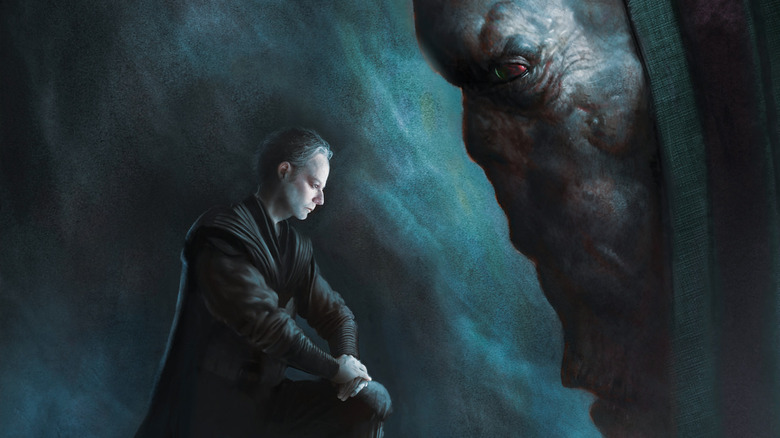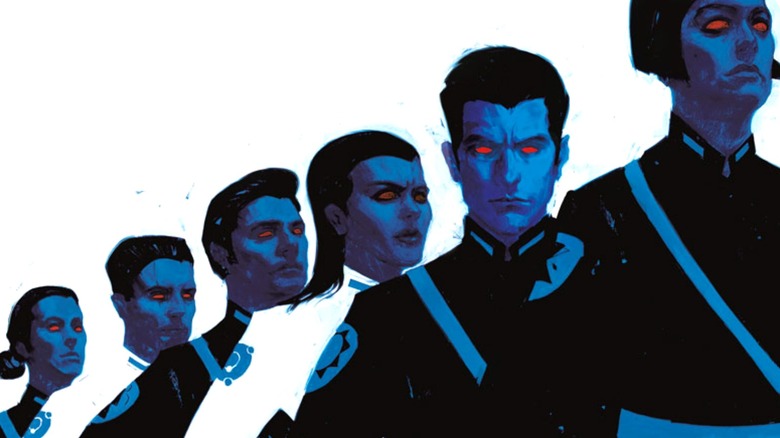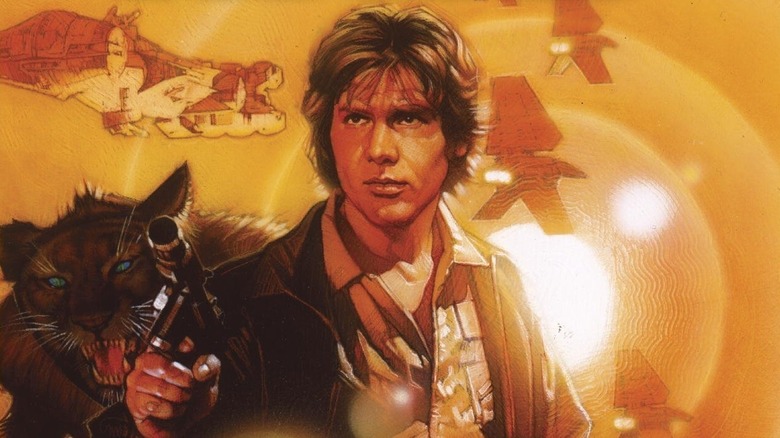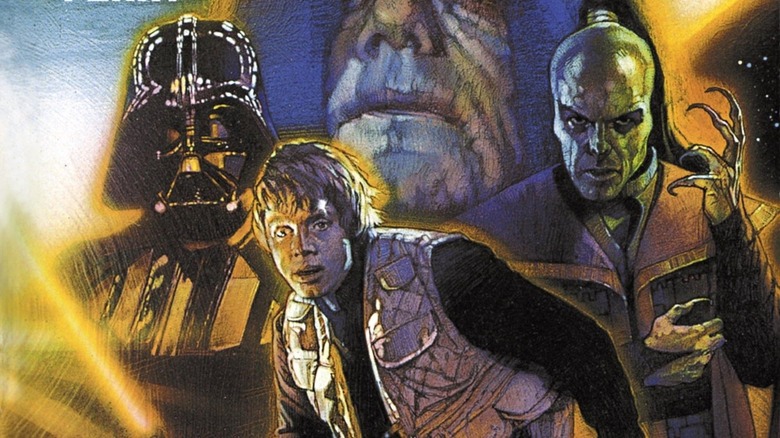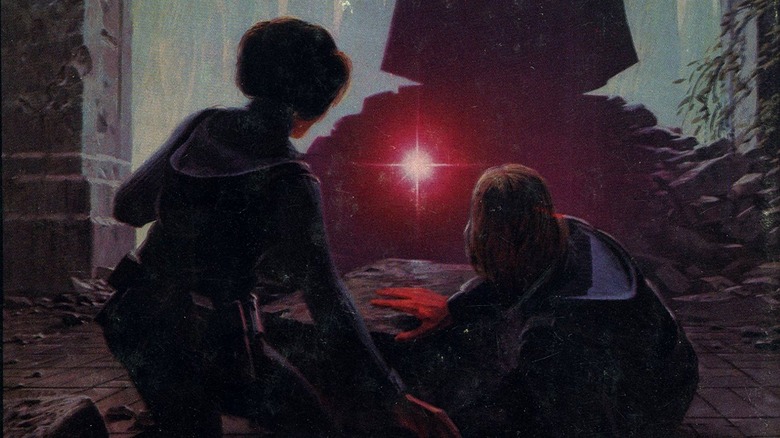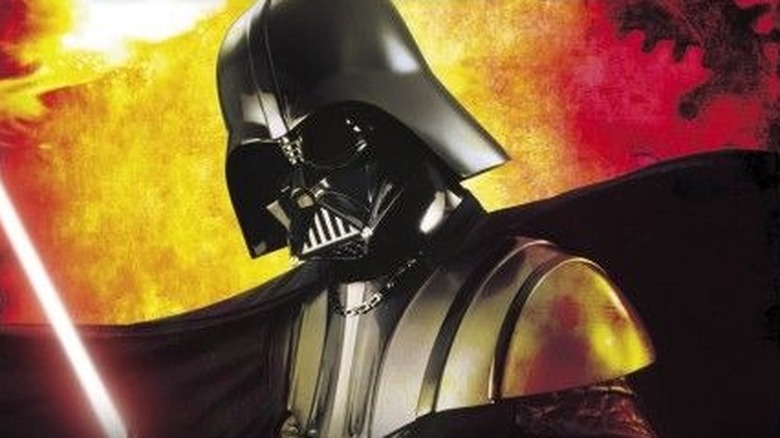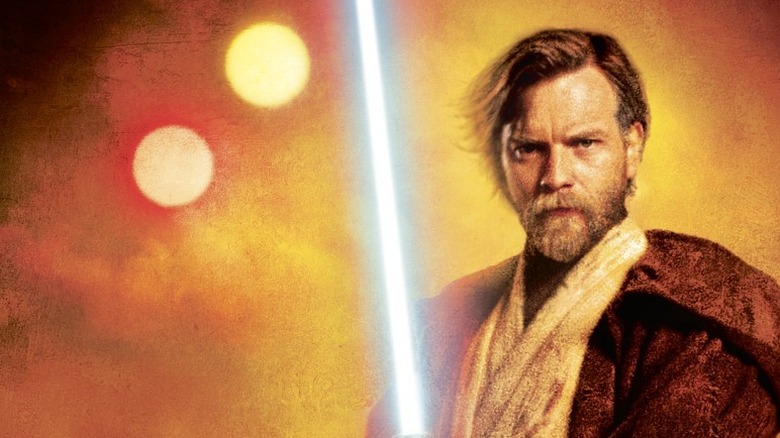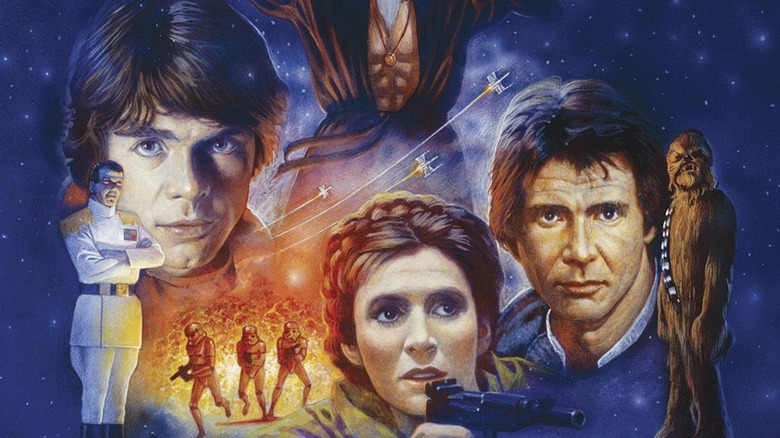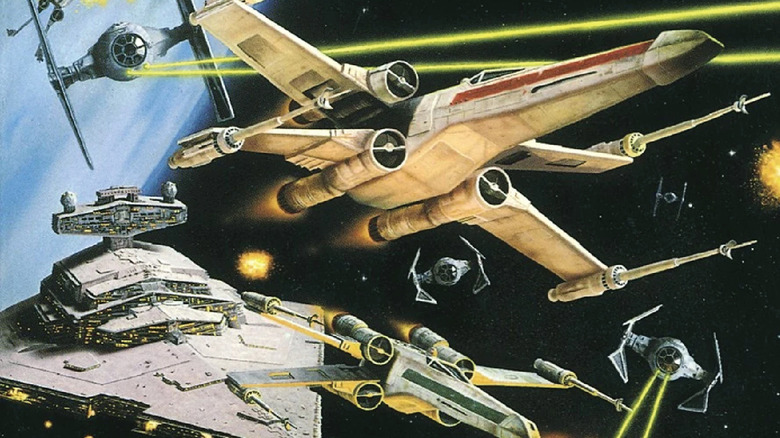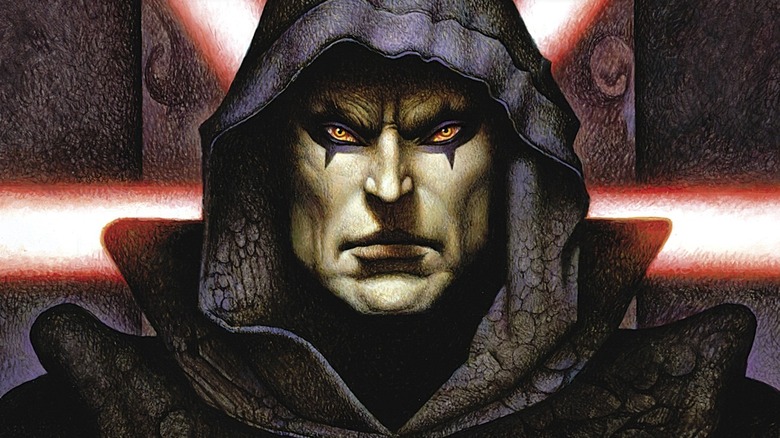The 20 Best Star Wars Books Ever Written
We may receive a commission on purchases made from links.
In the "Star Wars" universe, films and television shows may be the big events, but literature has been integral to the franchise since the very beginning. The first piece of "Star Wars" media ever released was the official novelization by author Alan Dean Foster, titled "Star Wars: From The Adventures of Luke Skywalker," which hit bookstores in November 1976, months before the film arrived in theaters. Two years later, Foster returned to pen the first official spinoff novel, "Splinter of the Mind's Eye."
When the prospects of a prequel trilogy were only whispers, "Star Wars" books filled the void for fans. The 1991 release of Timothy Zahn's "Heir to the Empire" told an exciting new adventure that followed the exploits of Luke, Leia, Han, Chewie, Lando, and the droids after the end of "Return of the Jedi." "Heir to the Empire" inspired two sequels, "Dark Force Rising" and "The Last Command," opening up a new era of "Star Wars" publishing in which authors had the freedom to continue the stories of their favorite characters. The prequels created more opportunities, and "Star Wars" authors eagerly delved into the new era, mapping out a history of the galaxy far, far away that spanned over 25,000 years.
Then, Disney rebooted the "Star Wars" timeline in 2013 and kicked off a new wave of "Star Wars" books, relegating the older novels to the non-canon "Legends" line. Still, many of the greatest "Star Wars" stories ever told are on the page, not the screen. Let's take a look at some of the best "Star Wars" books ever written.
20. Aftermath by Chuck Wendig
Chuck Wendig didn't set out to create a platform for a new expanded universe like Timothy Zahn did with the original Thrawn trilogy. "Aftermath" sprawls, yes, introducing new characters by the bucketload, some of which dance in and out of these post-"Return of the Jedi" events with dizzying speed. But Wendig spends most of his time examining the humanity of the occupants of this brave new world, spending time with former Imperials and Rebels alike. "Aftermath" does what it says, showing the difficulties of rebuilding a functioning society in the wake of a total collapse of power.
There are some terrific oddballs in the "Aftermath" cast, like the reconfigured battle droid Mister Bones, who has the soul of an HK unit in a B2's roger-roger body. "Aftermath" also introduces "The Mandalorian" favorite Cobb Vanth, relating Vanth's version of the story of how he came by Boba Fett's armor (and Wendig was actually disappointed in the character's appearance in "The Book of Boba Fett"). Hidden among the overarching plot are some great, poignant scenes — Wendig even grants the (overly) reviled Jar-Jar a bittersweet finale, one that gives the Gungan the audience he always deserved: children. While there are two more installments in the "Aftermath" series, the first is one of the very best "Star Wars" books and incredibly foundational to the New Republic era. (Margaret David)
19. The High Republic: Light of the Jedi by Charles Soule
Charles Soule's 2021 novel "The High Republic: Light of the Jedi" (read our review) is the first in a series of stories chronicling the Jedi Order 200 years before the events in "The Phantom Menace." Here, peace reigns across the galaxy, but a cataclysmic event forces our heroes to use their powers to prevent more destruction while investigating the reason for the occurrence.
"Light of the Jedi" offers a fascinating look at the Jedi and their mystical connection to the Force. While the narrative drags in places, introduces too many characters without settling on a central figure to rally around, and lacks a discernible villain beyond some hapless space pirates known as the Nihil, the epic adventure and high stakes make for a fun, if not brisk, read. Each chapter follows a different perspective that ends on an unresolved cliffhanger until further into the story. This approach might frustrate some readers but also swiftly establishes several characters who appear in additional content down the road.
Ultimately, this is a tale that celebrates the Jedi Order and its profound impact on the galaxy during a more peaceful era. We witness new powers and abilities, such as the Jedi's ability to fly ships with their minds, and see the Jedi working together harmoniously, free from the disruptions of the Sith. Action-packed and often intense, "Light of the Jedi" is a testament to the enduring spirit of the Jedi and a must-read for Star Wars fans. (Jeff Ames)
18. Darth Maul: Shadow Hunter by Michael Reaves
More Darth Maul is never a bad thing (see: "The Clone Wars" animated series). Indeed, following the red and black painted Sith's very brief appearance in "Star Wars: Episode I — The Phantom Menace," fans clamored for more, particularly after watching the horned baddie whip out that gnarly double-bladed lightsaber, and now Maul has a whole complicated timeline in the "Star Wars" universe.
Luckily, Michael Reaves' "Darth Maul: Shadow Hunter" sheds more light on the mysterious figure and follows Maul as he hunts down Darth Sidious' enemies days before the Trade Federation's Naboo Blockade seen in "The Phantom Menace." Reaves goes into great detail about the criminal activity occurring within Coruscant's lower levels and stretches the premise for all its worth, even if the whole affair is too contrived to accept fully.
Maul runs amok through dark alleyways, operating like an unstoppable killing machine, basically like a ninja Terminator. The Sith apprentice decapitates his enemies and slices off their arms, all with an aura of cockiness that makes Han Solo look like C-3P0 by comparison. Still, Reaves never digs into Maul's head, preferring to focus on a smart-a** droid named I-Five and Darsha Assant, a young Padawan dealing with her own problems. As such, while Maul enjoys plenty of time in the limelight, he remains an enigma, requiring fans to search for additional content for a more insightful character dive. (Jeff Ames)
17. Lost Stars by Claudia Gray
The galaxy far, far away is filled with action and intrigue, but there's also room for romance. The canon novel "Lost Stars" follows the tragic story of two Outer Rim children who bond at an early age when their homeworld, Jelucan, joins the new Galactic Empire. Thane Kyrell and Ciena Ree are inseparable, dreaming of leaving their home planet behind and joining the Imperial Academy to become TIE pilots.
At first, the Empire seems like an exciting alternative to the underdeveloped farmlands of Jelucan, and the pair even earns an audience with Grand Admiral Tarkin. The two become heroes in their own rights as they rise through the Imperial ranks, but soon the deadly consequences of the Empire's expansion nag at Thane. After learning about the Death Star's power, Thane considers joining the Rebel Alliance; a critical meeting with Wedge Antilles seals his decision. Unfortunately, this means joining the side opposite his lifelong crush.
"Lost Stars" reimagines the events of the original trilogy from the perspective of those on the fringes of the story. It's interesting to see how Imperial propaganda mischaracterizes the Rebel Alliance and how noble people like Ciena are deceived into aiding the Empire and destroying innocent lives. Although it's classified as a YA novel, "Lost Stars" is one of the best "Star Wars" books for fans wanting a new take on this beloved universe. (Liam Gaughan)
16. Shadows of the Sith by Adam Christopher
It's rude of "Star Wars" to make fans read a novel in order to understand the sequel trilogy, much less to release the necessary tome several years after "The Rise of Skywalker," but Adam Christopher's "Shadows of the Sith" politely fulfills its duty. Written in clean prose and switching between characters' viewpoint at the right times to ensure narrative flow, this novel is truly the first step in a Dave Filoni-style redemption saga.
Remember how Max von Sydow played some cool dude for five minutes in "The Force Awakens"? This book gives him a purpose that matches his gravitas. The stupid subplot about the Sith assassin and an evil magic dagger? It sucks so much less after reading this. What was Lando's deal in the sequel trilogy, and why was there some truncated but important storyline about his daughter? Good news! Adam Christopher explains it well.
Even better, Christopher brings in a number of fresh and intriguing characters. Komat, a Sith acolyte introduced briefly in Wendig's "Aftermath," gets a larger role here, and she's one of the best book-only characters since Mara Jade, the villain turned Luke Skywalker's wife. "Shadows of the Sith" is necessary reading, and a great deal of fun. (Liam Gaughan)
15. Shatterpoint by Matthew Stover
Mace Windu, Yoda's second-in-command on the Jedi Council, starred in this Clone Wars-era novel that saw him return to his homeworld. Mace Windu was raised on Haruun Kal, a planet torn apart by a conflict called the Summertime War, which was fought between natives and outworlders. Windu remembers little of his past but asks for the assignment when his former padawan, Depa Billaba, goes missing on the planet.
Set only months after the conclusion of "Attack of the Clones," Windu is full of doubt. He's baffled that a galactic war was able to break out so quickly and worries that Billaba has turned to the dark side, exposing another one of the Jedi's blind spots. Although Windu is known for his restraint, he fights for a personal cause when the Separatist fleet attacks the place where he was raised.
"Shatterpoint" offers a rare window into Windu's mental state, as he keeps journals and wonders if Anakin truly is the Chosen One. While writing, author Matthew Stover was inspired by the classic Vietnam film "Apoclaypse Now," which, coincidentally, George Lucas himself had initially planned to direct. (Liam Gaughan)
14. Master and Apprentice by Claudia Gray
While Qui-Gon Jinn and Obi-Wan Kenobi had a mature and understanding relationship by the time of "The Phantom Menace," the early days of their partnership were anything but smooth. The maverick Qui-Gon was generally adverse to following the strict Jedi code, while his apprentice was a stickler for routine who struggled to connect with his strong-willed master. Claudia Gray's canon novel "Master and Apprentice" details an early adventure that brought the two closer together.
Qui-Gon is approached by Yoda with an invitation to join the Jedi Council; while Yoda himself does not approve of letting the troublesome master into the Jedi's inner circle, the other Jedi feel that Qui-Gon's unique perspective is needed. However, joining the council would force Qui-Gon to hand Obi-Wan's training to another Jedi master, a prospect that shatters his apprentice's heart. Obi-Wan feels that he is finally starting to connect with his austere master, and he fears disappointing him.
As Qui-Gon contemplates the decision, the two are dispatched on a mission to the planet Pijal, where a young ruler is threatened by an emerging terrorist organization. The assignment reunites Qui-Gon with another untraditional Jedi, Rael Averross, who lost his own padawan in a tragic skirmish. It's a thrilling adventure that fleshes out the interesting Qui-Gon and Obi-Wan dynamic; Obi-Wan's training was featured in the YA series "Jedi Apprentice," but few "Star Wars" books for older readers have covered this period. (Liam Gaughan)
13. Dark Disciple by Christie Golden
Some of the greatest "Star Wars" tales occur during the Clone Wars, a period of great turmoil and unrest in the galaxy. Author Christie Golden (working from never produced "Clone Wars" scripts written by Katie Lucas, Dave Filoni, and Matt Michnovetz) taps into this era for the thrilling and surprisingly emotional "Dark Disciple," which chronicles the Jedi Council's shady efforts to assassinate Count Dooku. They enlist the aid of Quinlan Vos, a promising young Jedi (who enjoyed a very brief cameo in "The Phantom Menace"), and Asajj Ventress, Dooku's former apprentice, to carry out the deed, unwittingly setting up a greater conflict with the dark side.
Similar to the animated "Clone Wars" series, "Dark Disciple" zips along at a nice pace, introducing new characters while expanding the lore of previously established icons. The story provides redemption for Ventress, giving the character closure and a decidedly happy ending. Moreover, we learn much about the dark side, its incredible power, and its unspeakable dangers.
Still, as engaging as the story can be, "Dark Disciple" never fully settles into a cohesive whole. Golden does her best to patch the gaps between each episode. Still, specific story beats and romantic subplots are clunky, and characters like Obi-Wan and Mace Windu seem to make bizarre decisions to propel the story forward. Nitpicks aside, fans of "Clone Wars" will find plenty to enjoy here and rest happily knowing that Ventress received a fitting conclusion to her story. (Jeff Ames)
12. Jedi Trial by David Sherman and Dan Cragg
One of the most important story developments between "Attack of the Clones" and "Revenge of the Sith" is Anakin's trial to become a Jedi Knight. The Clone Wars-era novel "Jedi Trial" sheds some light on this critical moment and proves Anakin's merit as a leader.
Anakin is tasked with a solo assignment to support an abandoned Republic outpost on the planet Praesitlyn. Protected only by a rag-tag group of battle-hardened Republic officers, Anakin must help the understaffed world mobilize as Count Dooku's minion Pors Tonith plots an invasion. Should Praestilyn be overrun with droids, the Separatists would gain access to vital hyperspace routes. Although action-packed, "Jedi Trial" is also heavy on wartime strategy, something not always present in "Star Wars" novels.
One of the darker books, "Jedi Trial" shows the toll war takes on combatants who don't have Force powers, and Anakin's leadership here explains why the Jedi Council granted him knighthood despite their misgivings about his impulsive attitude. (Liam Gaughan)
11. The Force Unleashed by Sean Williams
"The Force Unleashed" quickly became one of the most popular "Star Wars" video games of all time, but the story of Darth Vader's secret apprentice wasn't limited to those with a gaming console. Sean Williams penned a novelization that fleshed out the story of Galen Marek, the orphaned child of a Jedi Knight who is trained in the dark side by the Dark Lord of the Sith, and who takes on the codename "Starkiller."
Starkiller (voiced by "Star Wars" superfan Sam Witwer in the game) is tasked with assassinating the Jedi who survived Order 66, slaying such veterans as Shaak Ti and the ancient hermit Kazdan Paratus. As Starkiller grows closer to his master, Emperor Palpatine suspects the two are plotting his downfall and orders Vader to execute his apprentice. With nowhere else to run, Starkiller turns to his former adversary, Jedi Master Rahm Kota, who begins training him as a Jedi, hoping to make him a leader in the Rebellion.
"The Force Unleashed" retains all the excitement of the game while fleshing out Starkiller's romance with Juno Eclipse, an Imperial pilot who similarly questions her loyalties. Starkiller's shape-shifting droid PROXY provides comic relief, and prior to "Rogue One: A Star Wars Story," the book gave an alternate explanation of how the Rebel Alliance obtained the Death Star plans. Williams also penned the novelization of the sequel "The Force Unleashed 2," which follows Vader's attempts to clone his former protégé. (Liam Gaughan)
10. Darth Plagueis by James Luceno
The tragedy of Darth Plagueis the Wise is featured in one of the most iconic scenes in the Star Wars prequel trilogy, but it's not just a story. The Expanded Universe revealed that Plagueis was a real Sith Lord and that Palpatine was the apprentice who killed him. James Luceno's novel "Darth Plagueis" exposes the secret history of how Plagueis slew his own master, Darth Tenebrous, and became obsessed with studying midi-chlorians, with the ultimate goal of creating life.
Plagueis courted a younger Palpatine when he was still a politician on Naboo, only just discovering his Force abilities. Plagueis used Palptaine's political connections to infiltrate the Galactic Republic and led the InterGalactic Banking Clan under his public persona, Magister Hego Damask II. Together, Plagueis and Palpatine plant seeds of disillusionment in the government and stage the downfall of Supreme Chancellor Valorum.
Plotting to elect Palpatine as the Supreme Chancellor, Plagueis helps initiate the deals with the Trade Federation that lead to the conflict in "The Phantom Menace." However, Palpatine plots against his master by training the young warrior Maul as an assassin and seducing the Jedi Dooku to the dark side. After promising to make Plagueis his co-chancellor upon election, Palpatine betrays Plagueis and kills him in his sleep. Palpatine then continues Plagueis' exploration of the Force's ability to prolong life, aiming to make himself immortal. (Liam Gaughan)
9. Thrawn and Thrawn Ascendancy by Timothy Zahn
In 2016, Lucasfilm announced that Grand Admiral Thrawn would make his triumphant return to "Star Wars" canon as an antagonist for the crew of "Star Wars Rebels." Alongside that came the reveal that author Timothy Zahn was returning for a new trilogy of Thrawn novels. While it's not as foundational to the new "Star Wars" canon as the original Thrawn trilogy, Zahn's books keep Thrawn as intricate as ever, but also give him a new, entirely reasonable flaw. The new series showcases the early years of Thrawn's military service, starting with his exile from Chiss territory and his befriending of ambitious Imperial cadet Eli Vanto. Weaving in and out of established canon, the trilogy expands on his relationship with the Emperor and fleshes out fellow "Rebels" antagonist Arihnda Pryce along the way.
A second trilogy, "The Ascendancy," goes further back into Thrawn's history. The thorny politics of the Chiss are explored, as the young, adopted Thrawn earns the ire of some members of his new family. The Force-sensitive Chiss sky-walkers serve as a secondary focus, and Thrawn has to deal with his own culture's secrecy when dealing with a familiar threat. "The Ascendancy" is pure military science fiction, and a series a fan could use to woo their Honor Harrington-loving friends over to the galaxy far, far away. (Margaret David)
8. The Han Solo trilogy by A.C. Crispin
The 2018 box office bomb prequel "Solo" borrowed many elements from original Han Solo's backstory, which was first established in a trio of novels from author A.C. Crispin. "The Paradise Snare," "The Hutt Gambit," and "Rebel Dawn," which are now non-canon Legends, tell the story of the smuggler's early days as a Corellian outlaw who enlists to become an ace Imperial fighter pilot. As in "Solo," Han becomes disillusioned by the Empire and rescues a mistreated Chewbacca, who swears him a life debt as his co-pilot.
Many of the events in "Solo" first happened on the page, including Han's victory over Lando Calrissian in the card game that won him ownership of the Millennium Falcon. However, some things are different; instead of Qi'ra, young Han falls for Bria Tharen, a wealthy Corellian girl who is unable to come to terms with Han's illegal profession. A heartbroken Han even pilots a ship he christens Bria before he develops a more callous attitude.
Other events diverge from "Solo" and tie more directly to the original Star Wars trilogy. "Rebel Dawn," for example, is about the botched mission that forces Han and Chewie to dump a valuable shipment of spice, angering their employer, Jabba the Hutt. Both fans who loved "Solo" and those who were underwhelmed might enjoy this alternate origin story for the "Star Wars" universe's most beloved smuggler. (Liam Gaughan)
7. Shadows of the Empire by Steve Perry
In 1996, Lucasfilm launched the most ambitious project the Expanded Universe had seen yet. Preparing the market for the release of "The Phantom Menace" and the "Star Wars" Special Editions, a top-tier creative team was tasked with creating a multimedia event that would mimic the year-long marketing campaign surrounding a film. The story group developed "Shadows of the Empire," an interconnected narrative told through a novel, a junior novelization, a video game, a comic book series, a roleplaying game, merchandising, and even an official soundtrack.
"Shadows of the Empire" bridges the gap between "The Empire Strikes Back" and "Return of the Jedi," as Luke, Leia, Chewie, Lando, and the droids search for Boba Fett, who still holds Han as his carbonite-frozen captive. In order to enter the world of "scum and villainy," they enlist the help of smuggler Dash Rendar, an old rival of Han's. The novel also gives insight into Luke's shattered emotions, as he's still processing the revelation that Vader is his father.
"Shadows of the Empire" introduced the Black Sun organization, a powerful crime syndicate that forms an alliance with the Galactic Empire in order to track down Luke. Black Sun's leader Prince Xizor (who eventually re-entered "Star Wars" canon) harbors an intense hatred for Darth Vader, who devastated his homeworld of Falleen with a biological weapon, and aims to kill Vader's son out of revenge. Xizor plots to replace Vader as Emperor Palpatine's second-in-command and energizes the criminal underworld to search for Skywalker. (Liam Gaughan)
6. Splinter of the Mind's Eye by Alan Dean Foster
After writing the original novelization of "Star Wars," author Alan Dean Foster was hired to write a sequel, "Splinter of the Mind's Eye." George Lucas' plan was to have a second story ready in case "Star Wars" bombed at the box office. If "Star Wars" underperformed, its sets could be reused for a low-budget sequel featuring some of the principal cast members. After the film broke box office records, however, "Splinter of the Mind's Eye" was repurposed as the first spinoff novel.
The book follows Luke, Leia, and the droids as they search the mining colony Mimban for a kyber crystal, which is referred to as a powerful Force artifact. The Expanded Universe would later establish that Kyber crystals are the energy source that powers lightsabers, an idea that has persevered into the Disney era.
The story is bound by the constraints of a smaller film. The locations are mostly murky forests and sets that appeared in the first film, and only Luke and Leia are featured (a return appearance wasn't in Harrison Ford's original contract). Lucas had Foster cut out a space battle that would've been too expensive to film, but the book did feature the first lightsaber battle between Luke and Darth Vader a full two years before "The Empire Strikes Back." There are also hints of a romance between Luke and Leia, as Foster was unaware that they were siblings. (Liam Gaughan)
5. The Dark Lord trilogy by James Luceno
This trilogy of novels follows Anakin's transition into Vader both before and after the events of "Revenge of the Sith," an evolution inspired by the horror classic "Frankenstein." "Labyrinth of Evil" takes place over the last days of the Clone Wars, detailing Anakin and Obi-Wan search for Count Dooku's shrouded master while General Grievous plots to kidnap the Chancellor. Similar to the animated "Star Wars: Clone Wars" micro-series, the novel by James Luceno teases the battle above Coruscant that begins "Revenge of the Sith."
The middle part of the trilogy, Luceno's adaptation of "Revenge of the Sith," is more in-depth than any other "Star Wars" movie novelization. It includes scenes cut from the film, such as Padme's early involvement with the Rebel Alliance. It also details Vader's state of mind as he lies dying on Mustafar, dwelling on his presumed role in Padme's death and his anger towards Obi-Wan. It's a much more satisfying conclusion than the cheesy wail that Vader unleashes in the actual film.
Finally, "Dark Lord" begins in the early days of the Galactic Empire, as Padme's bodyguard Captain Typho searches for the whereabouts of Anakin, presumed missing at the end of the Clone Wars. Meanwhile, Jedi Masters Roan Shryne and Bol Chatak and padawan Olee Starstone manage to survive Order 66 and make an alliance with Chewbacca as the Empire invades Kashyyyk. (Liam Gaughan)
4. Kenobi by John Jackson Miller
Released near the end of the old Legends continuity, John Jackson Miller's "Kenobi" contains a wealth of detail about the Jedi's life as an exile that still will appeal to readers today, even if you know that this story won't bear much resemblance to Obi-Wan's Disney+ series, which George Lucas loved. Obi-Wan's memories of Duchess Satine Kryze follow him to Tatooine, where he continues to keep watch over the Lars homestead. But, ironically, this excellent "Star Wars" novel isn't being recommended for any possible connections to "Obi-Wan." This one's for the fans of the Tusken Raiders in "The Book of Boba Fett."
In addition to the heavy Western overtones of Ben's attempts to assist a frontier woman and her dubious suitor, Obi-Wan spends a lot of time getting to know a Tusken chief named A'Yark. She's ferocious but honorable, the clear spiritual predecessor to Boba Fett's warrior teacher. She's since made it into the new canon via another story by Miller. That short tale, "Rites," is found in "Star Wars: From a Certain Point of View," where A'yark still knows who old Ben is. (Margaret David)
3. The Thrawn trilogy by Timothy Zahn
Perhaps the most important "Star Wars" novel ever written, "Heir to the Empire" kicked off the Expanded Universe. While the post-"Return of the Jedi" era had briefly appeared in the original run of Marvel comics, the period was largely unexplored before Timothy Zahn's novel hit shelves in 1991. The book picks up five years after the destruction of the second Death Star. The New Republic has been established, but its expansion is hindered by the remaining Imperial forces.
Former Imperials unite under the command of Grand Admiral Thrawn, an alien strategist who discovers secrets buried in Emperor Palpatine's personal vaults. Amassing a fleet of ships and unleashing the threat of a crazed former Jedi, Thrawn sets his sights on retaking the former Imperial capital, Coruscant. Thrawn instantly became a fan-favorite character, and made his transition to the new "Star Wars" canon when he appeared in the animated series "Rebels," before becoming a key part of the "Ahsoka" TV series.
"Heir to the Empire" establishes that Han and Leia were married and expecting twin children, Jacen and Jaina, but that isn't the only romance. In "Heir to the Empire," Luke crosses paths with former dark side acolyte Mara Jade, and while the two are initially forced into a shaky alliance, they eventually develop feelings for each other. Mara Jade emerged as a hero in Zahn's sequels, "Dark Force Rising" and "The Last Command." (Liam Gaughan)
2. The X-Wing Series by Michael A. Stackpole and Aaron Allston
Die-hard "Star Wars" fans seeking more epic space battles should turn to "The X-Wing Series" by Michael A. Stackpole and Aaron Allston. This sprawling saga, described by many as "Top Gun" in space, consists of 10 books and follows famed pilot Wedge Antilles (played in the movies by Denis Lawson, giving his nephew Ewan McGregor a deeper connection to "Star Wars") and his elite band of rebel fighters as they battle dark forces across the galaxy.
"Rogue Squadron," written in 1996, kicks off the fun and finds Wedge navigating the New Republic alongside characters such as fan favorite Corran Horn, Mirax Terrik, Erisi Dlarit, and Tycho Celchu. The following two books, "Wedge's Gamble" and "The Krytos Trap," form an excellent trilogy, and Stackpole leans hard on technical jargon, putting readers into the cockpits of these powerful X-Wings as they engage in ferocious battles over familiar locations like Coruscant. Allston's initial trilogy, namely "Wraith Squadron," "Iron Fist," and "Solo Command," expand the story even further, albeit with an added emphasis on adventure and humor, while the other four novels nicely round out the edges.
You need to read the whole series to get the complete picture, but each novel provides a thrilling story that expertly expands the "Star Wars" mythos in new and exciting ways. Uniquely, these stories work hand-in-hand with those early 90s LucasArts "X-Wing" games and a series of Dark Horse comic books written by Stackpole beginning in 1995. Dive in and enjoy! (Jeff Ames)
1. The Darth Bane trilogy by Drew Karpyshyn
Topping our list of the best "Star Wars" books ever, the Darth Bane trilogy tells the life story of a pivotal Sith lord. Set 1,000 years prior to the events of "The Phantom Menace," Bane was a grizzled miner who discovered his aptitude for the dark side and joined the ranks of the Brotherhood of Darkness, an army of Sith that waged a war against the Galactic Republic and the Jedi Order. While he relished the chance to join the group, Bane grew concerned that the competing Sith lords were too obsessed with securing power to rule the galaxy.
Bane devised the Rule of Two that George Lucas himself introduced in "The Phantom Menace." Under Bane's law, the Sith were limited to a single master and one lone apprentice. In the novels "Path of Destruction," "Rule of Two," and "Dynasty of Evil," Bane plots the downfall of both the Jedi and Sith and trains an apprentice, Darth Zannah. As a result of Bane's rule, Zannah plots to assassinate her master and take on an apprentice of her own.
The trilogy concludes the Old Republic era of the "Star Wars" timeline and initiates the 1,000 years of peace that precede "The Phantom Menace," during which the Jedi Order ended their involvement with the military, thinking that they had defeated the dark side. (Liam Gaughan)
